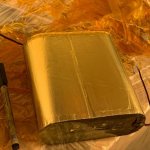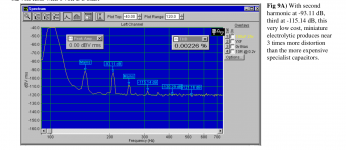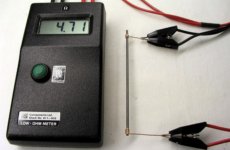On a decent sounding YT, the PX is more balanced; the Std. Z does the same thing it seems regardless of value; emphasizes the high treble and reduces the lower treble and upper mids. More testing later but the trend is the same it seems; Standard Z would be a good choice for tweeters that lack top octave sparkle. It would be a bad match for brighter sounding tweeters, especially in the top octave. More later...
sorry but blind test only test you not caps, is a faulty test !Do a real blind test and save yourself a lot of money in the future.
here we are diy with 10-20-30 years, some more of bulding experience...
thank you! 😉On a decent sounding YT, the PX is more balanced; the Std. Z does the same thing it seems regardless of value; emphasizes the high treble and reduces the lower treble and upper mids. More testing later but the trend is the same it seems; Standard Z would be a good choice for tweeters that lack top octave sparkle. It would be a bad match for brighter sounding tweeters, especially in the top octave. More later...
Last edited:
just ask to John Curl....😉Mr Fawlty,
You just dismissed all science in the world 😱) Suitable name BTW!
For A/B blind testing...I have said this elsewhere; I have friends and family over; they are all musicians. I do A/B for them; I know what I am doing but they do not. They almost ALWAYS agree with me as to what differences I am hearing and agree with me what they think sounds better. When a bunch of musicians of different eras and generations and genres all agree on something; that certainly works for me!
OK, here we go; latest results...The PX is more balanced than the Std. Z; just as before but now we have on my same David Arnay CD so I am more confident in the results.
I just tried the Sonic Cap (Gen 1) 2.0 vs ESA 2.2 vs Std Z 2.2 uF. The ESA and Sonic Cap sound very similar but the ESA has just a touch more detail than the Sonic Cap but the SC has just a little better highest treble (close, very close). I am basing this on the higher frequencies alone because of course 2.2 uF will go a little lower in the upper mids than 2.0 uF. So, the experiment with the two SC 2 uF in parallel was not a valid comparison unless of course you do that purposely; no reason to do that if the SC cost several times more than the ESA. Again, the Std Z emphasizes the high treble WAY more than the others.
Could I be happy with the ESA?, short answer...YES!
ESA standing?... still better than the Standard Z and Audyn Q4; not quite as good as the CSA and so on...
OK, here we go; latest results...The PX is more balanced than the Std. Z; just as before but now we have on my same David Arnay CD so I am more confident in the results.
I just tried the Sonic Cap (Gen 1) 2.0 vs ESA 2.2 vs Std Z 2.2 uF. The ESA and Sonic Cap sound very similar but the ESA has just a touch more detail than the Sonic Cap but the SC has just a little better highest treble (close, very close). I am basing this on the higher frequencies alone because of course 2.2 uF will go a little lower in the upper mids than 2.0 uF. So, the experiment with the two SC 2 uF in parallel was not a valid comparison unless of course you do that purposely; no reason to do that if the SC cost several times more than the ESA. Again, the Std Z emphasizes the high treble WAY more than the others.
Could I be happy with the ESA?, short answer...YES!
ESA standing?... still better than the Standard Z and Audyn Q4; not quite as good as the CSA and so on...
😀sorry but blind test only test you not caps, is a faulty test !
here we are diy with 10-20-30 years, some more of bulding experience...
And how do you know how much experience I have?
From a technical point of view, the standard z-caps are so good that you don't need a better one.
If you really want to do something good for the sound, then you should select the x-over components.
I bet you would ALL fail the blind test.

i believe we all have different sensitivities for our senses, some can not smell a thing even with its nose stuck up in a dirty mans arm pit, some eat dog food, some can go outside in t-shirt only in freezing winter, some must wear sunglasses indoor, some must use hearing aid
I never heard of Ansar, I am on their website now. I clicked the button for get samples but nothing happened. Are they only available in the UK? I would love to try some!
I would also like to try Clarity Cap CMR, here the price is 36.66 pounds in the UK, that is about $51 US for 3.3 uF 400 Volt so pricier than even the Aluminum Z!
ClarityCap CMR 400Vdc range | Hifi Collective
ClarityCap CMR 400Vdc range | Hifi Collective
hah! Too rich for me at the moment! I did a test on another thread; my 5 inch budget 2-way. I took a Superior Z and by passed with the Audyn Plus and a CDE 940C; it sounded as good if not better than the Audyn copper foil capacitor. Many people also try to tell me bypassing doesn't work, it makes things worse and other things. Guess what? It DOES work, it works very well in fact. Again, people that haven't actually tried these things for themselves are missing out. Again, I encourage everyone to experiment; you can talk the talk but until you walk the walk, you will never really know...
just ask to John Curl....😉
Sorry, I try to use logic and my own experience, not opinions of other people. I work daily with evaluations as profession...
No problem; I have done speakers for 53+ years now and started reading music and playing instruments 56+ years so when I tell you I can clearly hear a difference; you can believe it...FWIW...
HI that's nice .... but we know and we hear THD and micron vaporized metalizzed alu caps are for sissies we use real copper foil caps 😀Sorry, I try to use logic and my own experience, not opinions of other people. I work daily with evaluations as profession...
Attachments
Ps
dont forget the resistor ...have a fun 😛
@Peter ,I and John we had a good time here with the inventor of the abx test ArnyK....
dont forget the resistor ...have a fun 😛
@Peter ,I and John we had a good time here with the inventor of the abx test ArnyK....
Attachments
Last edited:
I wish I still had easy access to all of the test and measurement equipment I used daily at work! We had an 800 line HP DSA (dynamic signal analyzer) which was more than just a spectrum analyzer. Lets say we have 800 individual bins and set the BW for 1 decade; 2 KHz to 20 Khz. I would then try many various test signals on each capacitor under test and look for subtle differences in the resulting spectrum. I can say with great confidence that there must be some sort of spectral imbalance on these various capacitors that sound different; how else would you explain it? For example, some emphasize the top octave, 10 to 20 KHz while others emphasize the lower octaves say maybe 3 to 6 Khz? The perfect (ideal) capacitor would not emphasize any part of the spectrum at all. This is why I think a home based test is not probably precise enough but I will admit ignorance to the state of the art software and hardware that is PC based specifically designed for home DIYers!
- Status
- Not open for further replies.
- Home
- Loudspeakers
- Multi-Way
- jantzen standard z cap vs claritycap ESA


